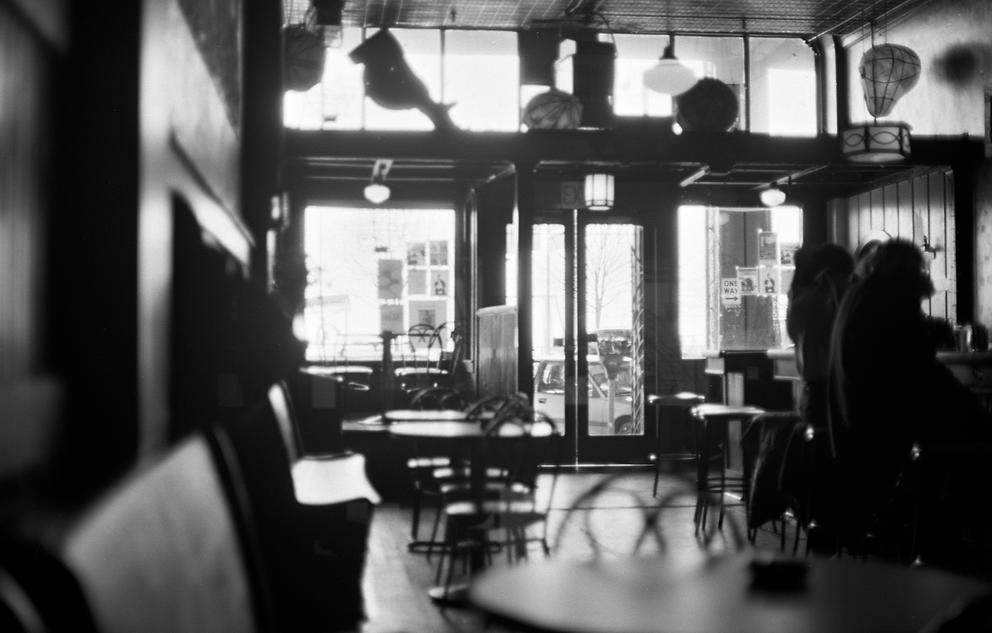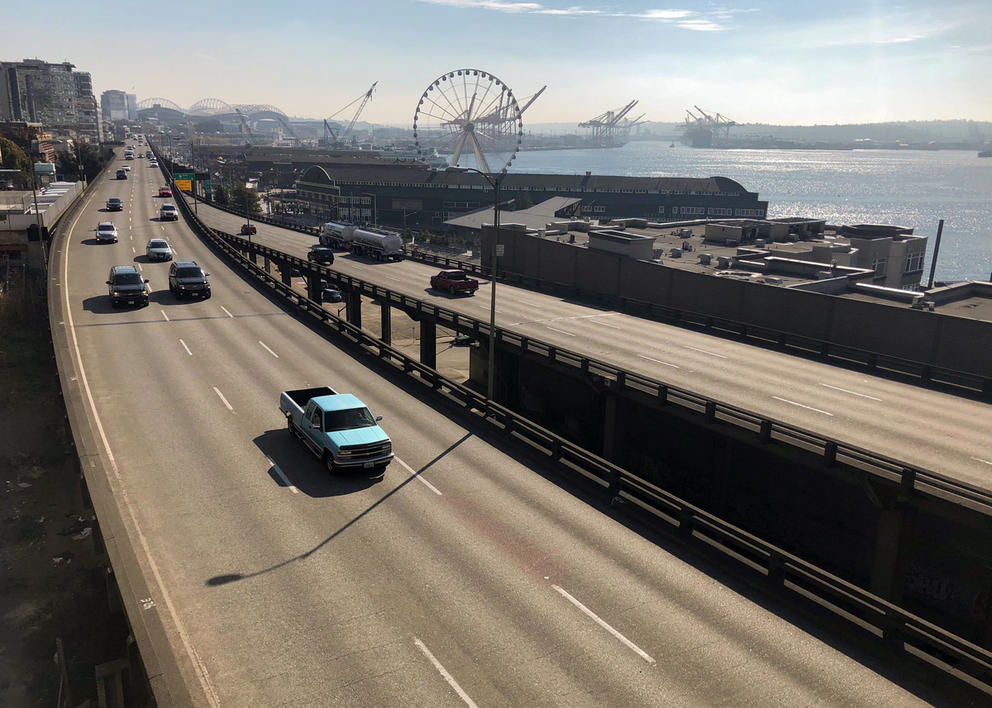Other than the tofu and imitation eggs, this section of the famous club looked exactly as it did back in 1991, when the OK (as it was commonly known) was the hottest spot in Seattle — and the place where Nirvana debuted “Smells Like Teen Spirit.” The fir flooring revealed streaks and creaks from a thousand Doc Martens. Above the doorway, the same transom windows brought in a few sparse shafts of natural light. And nearby was the same alcove where Eddie Vedder appears in the movie “Singles,” reading Seattle music magazine The Rocket.
Steps away from Vedder’s perch is Isle of Plants, a new, vegan-only microgrocery. It occupies just a small slice of the OK’s footprint and, for now, it’s open only from Friday through Sunday, 10 a.m. to 4 p.m. But a vegan grocery is an intriguing reimagining of a historic space in Seattle, where old buildings are so often demolished. History has proved it’s particularly difficult for music clubs to get protected status. (The fate of the Showbox still hangs in the balance, with ongoing legal and governmental battles that began in 2018.)
After visiting on a weekend in late April, I can say confidently that I am the first patron of Isle of Plants to have seen Mother Love Bone play in the same space as the broccoli. It was such an odd experience, but it got me thinking about the role that the OK Hotel played in Seattle culture.
Built by Harry Buttnick (an early producer of water repellant for outdoor clothing), the original hotel opened in 1917. The upstairs rooms housed workingmen who could see straight across to Elliott Bay until 1919, when a new elevated railroad trestle obstructed the view. The ground floor offerings have shifted over the past century, from Buttnick’s OK Loan to luggage, clothing and hardware. Once the Alaskan Way Viaduct went up in the 1950s, the entire building was cast in shadow. But the viaduct’s constant hum of traffic also meant when the OK music club moved in, it avoided the noise complaints that have plagued other venues in the city.
The OK was open from 1987 until 2001, when the Nisqually earthquake damaged the building and forced the club to close. In its heyday, the club included a coffee shop, a café and a gallery, and eventually a bar. It always felt a bit patched together, with a narrow entryway and staircase in what was formerly the lobby of a long-dilapidated hotel. What started as one tiny room for live music eventually became two stages in the same building, after a woodworking shop at the back was turned into the mainstage. (The building was carved up even more when it was turned into apartments in 2004.) The club’s bookings were always eclectic — from Beck to Bill Frisell — but it was undoubtedly one of the incubators of the Seattle’s late 20th century music scene.
“Almost every musician in Seattle hung out there,” recalls Carrie Akre, who fronted Hammerbox and Goodness. “It was kind of like Seattle’s clubhouse for musicians. It was the place that made me who I am.”
Larry Steiner, of the band El Steiner, says almost exactly the same thing. “That place made me,” he swears. “It was my favorite venue of all time. At one show, opening for Sweaty Nipples, I decided to play naked. I played the entire show completely naked.” Steve Freeborn, who created the OK with Tia Matthies, says, “That was the OK — we let almost anyone play there and, as a result, many bands got their start.”
The club hosted thousands of bands over its 15-year lifetime, but the Nirvana show in April 1991 is the most famous, thanks to the debut of “Smells Like Teen Spirit.” The gig was Nirvana’s attempt to raise enough gas money for the trip to California to record Nevermind. “I think they made a couple thousand bucks,” Freeborn says.
In Cameron Crowe’s 1992 movie Singles, the OK played the role of “Java Stop,” a central hangout. The space hosted Vedder as both a bit actor in the film and as a real band member. Pearl Jam performed in the club unofficially and often, Freeborn says, but officially its members played their last show there under their early name “Mookie Blaylock” in March 1991. (They had named themselves after the basketball player, but were forced to switch it, and thus came Pearl Jam.)
The venue began as an all-ages club, but at some point, Freeborn realized a couple of nearby bars were making more money off the OK’s patrons than the club was. He decided to add a bar, and asked Pearl Jam’s Stone Gossard for the money to do so.
“I asked Stone if I could borrow $5,000,” Freeborn recalls. “Stone wanted to know how much he’d have to loan me to keep it all ages, and I said $300,000 a year. He loaned me $10,000 instead, for just the bar, and the bar was successful, and I paid him back. He said I was one of the few who ever repaid him.”
Because the OK club began as all ages, it was a place where many young Seattle musicians hung out. Most bills included four bands, so there were opportunities for groups just starting out to get stage time. “Bands bonded together there, and Steve and Tia were like parents,” says Akre. “A lot of interaction happened. As a result, it was the place that held all Seattle music together.”
The club was possible only because Pioneer Square during that era was rough around the edges and rents were cheap. Now the neighborhood is in flux: missions and shelters mix with swanky new hotels and offices, and the waterfront renewal project is well underway. But for the moment it’s still relatively affordable, which is why the Isle of Plants owners were able to move in. Partners Michelle Rabena and Hayden Stanko — both of whom grew up in Auburn — raised just over $19,000 in a Kickstarter campaign this past September and signed a three-year lease on the space.
With the Alaskan Way Viaduct demolished, the OK Hotel building once again fronts the water, making it prime real estate for the first time in ages. That was the strangest thing about visiting the site last month. I had never been in the OK when any sunlight had hit the building, as the viaduct had served as a giant shade for all those decades. “The place was a dark cavern,” recalls Akre.
When Freeborn and partner Matthies discovered the building in the mid-1980s, it was an abandoned fleabag hotel with 300 tiny rooms. “We had to drag hundreds of beds out of there when we cleaned it up,” Freeborn says of the creation of the OK. They were able to rent cheaply in part because, as with much of Pioneer Square, the property was owned by a family that saw it as a longtime investment. “My landlords wouldn’t pay to fix a single thing,” Freeborn recalls. “I never had a lease. We could have had to close at the end of any month, but we kept it going for 15 years.”
Over the years, the club hosted Jane’s Addiction, Hole, D.O.A., the Goo Goo Dolls and many other bands when they were up and coming. Whether it was avant-garde jazz or funk/rock or punk, pretty much everyone who ever played the OK was an “alternative” band (appropriately, Isle of Plants focuses on “alternative” meat and dairy). The space was important enough to late-1980s California band Sublime that it’s mentioned on the group’s song “Thanx,” from its debut album. Queens of the Stone Age played their very first live show there, as Josh Homme then lived in Seattle and Freeborn gave him a slot. The OK also put on every major Seattle band of the era: Soundgarden, Mudhoney, The Gits, Tad, Love Battery, the U-Men and many more. In the later 1990s, the club booked more jazz, and became a place where locals Bill Frisell, Amy Denio and Wayne Horvitz would hang ou.
Freeborn and Matthies now run the Royal Room in Columbia City, another popular music club with eclectic bookings. Though they’ve re-created some of the original venue’s vibe at the Royal Room, Freeborn admits there’s never been anything else in Seattle like the OK Hotel.
The Central, the Crocodile, the Showbox, the Vogue and countless other clubs had a role in the Seattle music scene during that decade, but no other place had quite the same feel. “Some of it was simply the timing,” Freeborn says. “It was perfect timing for the perfect place.” But Akre points out a more concrete reason: “The stage was 2 feet off the ground, so all the performers were essentially on the same level as the audience,” she recalls. “It made audiences and bands very connected.”
Rabena and Stanko hope that Isle of Plants creates the same kind of connections for Seattle’s vegan community. Their goal is meant to be sustainable: Bring vegan food to an urban setting with limited grocery options. Currently, patrons order online and pick up their tofu and veggies at Isle of Plants. They hope that customers use transit or are already within walking or biking distance, but they will also run out to customer cars for pickup. “We see this is as something that will be good for people’s health, good for the environment and good for Seattle,” Rabena says.
With the store still in its fledgling days, I arrived late on a Sunday, and there wasn’t much left in stock, so I can’t speak to their selection. But what they lacked in packed shelves, they make up in passion. “We are committed to creating a hundred percent vegan hub for urban Seattle,” Rabena says. In addition, they plan to have “cooking classes, meet-ups, and taste testing” at the location.
Both Rabena and Stanko are 27, so neither ever experienced the OK as a venue, but given the history, they’ve been thinking of perhaps hosting small acoustic performances at some point, maybe on First Thursday Art Walk nights. “We’d welcome anyone who was here back in the day, too,” Rabena says. As the store ramps up, she says, more in-person shopping will be set up by the fall. A new park is opening across the street, so perhaps this storied location will once again be the center of cultural and societal shifts in ever-changing Seattle.
Get the latest in local arts and culture
This weekly newsletter brings arts news and cultural events straight to your inbox.





